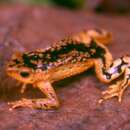Description
(
Anglèis
)
fornì da AmphibiaWeb articles
Diagnosis: Live specimens can be distinguished from similar species by its orange dorsum with large, irregular black marks in a wavy pattern, or a black dorsum with orange marks in a wavy pattern. These markings extend onto the dorsal surfaces of the limbs. The ventral side of the body, including the palms of the feet, is uniformly orange. Description:Atelopus patazensis has a robust body. The SVL of males is 37.8-39.8 mm and of females is 42.7-48.8 mm. The head length is about equal to the head width. A. patazensis has neither tympanic membrane nor tympanic annulus. The snout is truncated when viewed from the dorsal side and extends past the lower jaw. The forearms are short. The fingers have rounded pads and lack a circum-marginal groove. Relative length of fingers in increasing order are as follows: I,II,IV,III. The front foot is not webbed but the hind foot is webbed. The body’s dorsal surface on both males and females has warts. Females have pointed projections in the skin present in the postorbital area, dorsolaterally, and on the sides. Males have a row of large warts dorsolaterally and spiculae posteriorly on the throat and under the jaw (Venegas et al. 2008).Coloration: Colors vary dorsally from almost entirely black with orange patterning to almost entirely orange with black patterning. The pupil is black and fully encircled by a ring of dark gold. Preserved specimens lose their orange color and appear yellow. Colors vary dorsally from almost entirely black with orange patterning to almost entirely orange with black patterning (Venegas et al. 2008).Tadpole Morphology: A. patazensis belongs to the family Bufonidae, all of which have type IV tadpole morphology (Venegas et al. 2008).Species Authority: This species was first described by Venegas, Catenazzi, Siu-Ting, and Carrillo in 2008, but was first discovered by Rodriguez in 1993 (IUCN 2011).Etymology:The word “patazensis” comes from Pataz, the location in Peru where A. patazensis was found (Venegas et al. 2008).Synonymy/Taxonomy:A. patazensis was originally identified as A. pachydermis by Rodriguez in 1993 (Venegas et al. 2008).
Catenazzi, A., Lehr, E., Rodriguez, L., and Vredenberg, V. (2011). ''Batrachochytrium dendrobatidis and the collapse of anuran species richness and abundance in the Upper Manu National Park, southeastern Peru.'' Conservation Biology, 5, 382-391.
- autor
- Jillian Howard
- autor
- Thi Ngo
- autor
- Galena Robertson
Distribution and Habitat
(
Anglèis
)
fornì da AmphibiaWeb articles
A. patazensis is endemic to Cordillera Central in northwestern Peru in the Andes Mountains. It is specific to an inter-Andean valley near the village of Pataz between elevations of 2000-3000 m. It inhabits montane environments dominated by alpine grassland and along mountain streams, shrubs and bunch grasses. (Venegas et al. 2008)
- autor
- Jillian Howard
- autor
- Thi Ngo
- autor
- Galena Robertson
Life History, Abundance, Activity, and Special Behaviors
(
Anglèis
)
fornì da AmphibiaWeb articles
A. patazensis breeds in streams. After dissecting a dead female, it was found to be carrying 348 eggs with a diameter of 1.8-2.0 mm. (Venegas et al. 2008)
- autor
- Jillian Howard
- autor
- Thi Ngo
- autor
- Galena Robertson
Life History, Abundance, Activity, and Special Behaviors
(
Anglèis
)
fornì da AmphibiaWeb articles
This species is critically endangered due to a declining population. A potential cause of the declining population is the chytrid fungus. (Venegas et al. 2008)Causes also include energy production and mining, quarrying, pollution, domestic and urban waste water, and military effluents. (IUCN 2011)
- autor
- Jillian Howard
- autor
- Thi Ngo
- autor
- Galena Robertson
Relation to Humans
(
Anglèis
)
fornì da AmphibiaWeb articles
Informal mining activities introduced mercury into the streams inhabited by A. patazensis. Heavy metal concentrations have also been reported to exceed standards (IUCN 2011).
- autor
- Jillian Howard
- autor
- Thi Ngo
- autor
- Galena Robertson

